Parametric Multi-Objective Optimization of Urban Block Morphology Using NSGA-II: A Case Study in Wuhan, China
Abstract
1. Introduction
2. Literature Review
2.1. Urban Form and Building Energy Consumption
2.2. Multi-Objective Optimization Design of Urban Form
2.3. Urban Form and Environmental Comfort
2.4. Research Objectives
- (1)
- How do block typologies and height mixes affect the balance between solar, energy, and UTCI?
- (2)
- Utilize this framework to analyze residential neighborhoods in Wuhan, focusing on optimal neighborhood configurations, the interconnections between various objectives, and the influence of design variables on neighborhood efficacy.
- (3)
- Translate research findings into design guidelines to investigate the relationship between building energy consumption, daylighting, and outdoor thermal comfort in urban neighborhood forms. Discuss strategies for creating livable and energy-efficient urban neighborhoods while maintaining energy efficiency and environmental comfort.
3. Methodology
3.1. Theoretical Framework
3.2. Research Location
3.3. Parametric Block Modeling
3.3.1. Extracting and Simplifying Building Blocks
3.3.2. Setting the Ideal Neighborhood Form and Generating Building Blocks
3.4. Performance Simulation of Building Blocks
3.4.1. Total Energy Consumption Intensity of Buildings
3.4.2. Sunlight Hours
3.4.3. Universal Thermal Climate Index
3.5. Multi-Objective Optimization
4. Simulation and Result Analysis
4.1. Overall Optimization Trend Analysis
4.1.1. Multi-Objective Optimization (The First Simulation)
4.1.2. Multi-Objective Optimization (The Second Simulation)
4.2. Distribution of Pareto Optimal Solutions
4.3. Design Variable Analysis
4.4. Comparison of the Performance of the Selected Solutions
5. Discussion and Conclusions
5.1. Implication of This Study
5.1.1. Interrelationships Between Different Objectives
5.1.2. Impact of Design Variables on Block Performance
5.2. Conclusion and Future Work
Author Contributions
Funding
Institutional Review Board Statement
Informed Consent Statement
Data Availability Statement
Conflicts of Interest
Nomenclature
| Abbreviation | Explanation |
| Av.SH (h) | Average Sunshine Hours (h) |
| EUI (kWh/m2) | Energy Use Intensity (kWh/m2) |
| Av.UTCI (°C) | Average Universal Thermal Climate Index (°C) |
| bt | Building type index (genetic variable) |
| bf | Building floor number (genetic variable) |
| UWG | Urban Weather Generator |
| EPW | EnergyPlus Weather file |
| NSGA-II | Non-dominated Sorting Genetic Algorithm II |
Appendix A
References
- Alšauskas, O. World Energy Outlook 2024; International Energy Agency: Paris, France, 2024. [Google Scholar]
- Min, J.; Yan, G.; Abed, A.M.; Elattar, S.; Amine Khadimallah, M.; Jan, A.; Elhosiny Ali, H. The Effect of Carbon Dioxide Emissions on the Building Energy Efficiency. Fuel 2022, 326, 124842. [Google Scholar] [CrossRef]
- Omer, A.M. Energy, Environment and Sustainable Development. Renew. Sustain. Energy Rev. 2008, 12, 2265–2300. [Google Scholar] [CrossRef]
- Cronshaw, I. World Energy Outlook 2014 Projections to 2040: Natural Gas and Coal Trade, and the Role of China. Aust. J. Agric. Resour. Econ. 2015, 59, 571–585. [Google Scholar] [CrossRef]
- Li, J.; Colombier, M. Managing Carbon Emissions in China through Building Energy Efficiency. J. Environ. Manag. 2009, 90, 2436–2447. [Google Scholar] [CrossRef]
- Kropf, K. Aspects of urban form. Urban Morphol. 2009, 13, 105–120. [Google Scholar] [CrossRef]
- Oliveira, V.; Monteiro, C.; Partanen, J. A Comparative Study of Urban Form. Urban Morphol. 2014, 19, 73–92. [Google Scholar] [CrossRef]
- Sun, C.; Zhang, Y.; Ma, W.; Wu, R.; Wang, S. The Impacts of Urban Form on Carbon Emissions: A Comprehensive Review. Land 2022, 11, 1430. [Google Scholar] [CrossRef]
- Nieuwenhuijsen, M.; De Nazelle, A.; Pradas, M.C.; Daher, C.; Dzhambov, A.M.; Echave, C.; Gössling, S.; Iungman, T.; Khreis, H.; Kirby, N.; et al. The Superblock Model: A Review of an Innovative Urban Model for Sustainability, Liveability, Health and Well-Being. Environ. Res. 2024, 251, 118550. [Google Scholar] [CrossRef] [PubMed]
- Zhu, W.; Wang, J.; Qin, B. The Relationship between Urban Greenness and Mental Health: A National-Level Study of China. Landsc. Urban Plan. 2023, 238, 104830. [Google Scholar] [CrossRef]
- Yin, S.; Lang, W.; Xiao, Y. The Synergistic Effect of Street Canyons and Neighbourhood Layout Design on Pedestrian-Level Thermal Comfort in Hot-Humid Area of China. Sustain. Cities Soc. 2019, 49, 101571. [Google Scholar] [CrossRef]
- Askarizad, R.; He, J. Post-Pandemic Urban Design: The Equilibrium between Social Distancing and Social Interactions within the Built Environment. Cities 2022, 124, 103618. [Google Scholar] [CrossRef] [PubMed]
- Liu, S.; Wang, Y.; Liu, X.; Yang, L.; Zhang, Y.; He, J. How Does Future Climatic Uncertainty Affect Multi-Objective Building Energy Retrofit Decisions? Evidence from Residential Buildings in Subtropical Hong Kong. Sustain. Cities Soc. 2023, 92, 104482. [Google Scholar] [CrossRef]
- Li, J.; Wang, Y.; Xia, Y.; Song, Y.; Xie, H. Optimization of Urban Block Form by Adding New Volumes for Capacity Improvement and Solar Performance Using A Multi-Objective Genetic Algorithm: A Case Study of Nanjing. Buildings 2022, 12, 1710. [Google Scholar] [CrossRef]
- Liu, K.; Xu, X.; Huang, W.; Zhang, R.; Kong, L.; Wang, X. A Multi-Objective Optimization Framework for Designing Urban Block Forms Considering Daylight, Energy Consumption, and Photovoltaic Energy Potential. Build. Environ. 2023, 242, 110585. [Google Scholar] [CrossRef]
- Liu, P.; Hussein, A.A.; Alizadeh, A.; Baghoolizadeh, M.; Yan, G.; Zargari Pour, M.; Alkhalifah, T. Multi-Objective Optimization of Office Building Envelopes Properties and Venetian Blinds Using NSGA-II to Save Energy Consumption and Enhance Thermal and Visual Comfort. Case Stud. Therm. Eng. 2024, 64, 105484. [Google Scholar] [CrossRef]
- Castrejon-Esparza, N.M.; González-Trevizo, M.E.; Martínez-Torres, K.E.; Santamouris, M. Optimizing Urban Morphology: Evolutionary Design and Multi-Objective Optimization of Thermal Comfort and Energy Performance-Based City Forms for Microclimate Adaptation. Energy Build. 2025, 342, 115750. [Google Scholar] [CrossRef]
- Zhang, Y.; Teoh, B.K.; Zhang, L. Multi-Objective Optimization for Energy-Efficient Building Design Considering Urban Heat Island Effects. Appl. Energy 2024, 376, 124117. [Google Scholar] [CrossRef]
- Salat, S. Energy Loads, CO2 Emissions and Building Stocks: Morphologies, Typologies, Energy Systems and Behaviour. Build. Res. Inf. 2009, 37, 598–609. [Google Scholar] [CrossRef]
- Liu, X.; Sweeney, J. Modelling the Impact of Urban Form on Household Energy Demand and Related CO2 Emissions in the Greater Dublin Region. Energy Policy 2012, 46, 359–369. [Google Scholar] [CrossRef]
- Krüger, A.; Kolbe, T.H. Building Analysis for Urban Energy Planning Using Key Indicators on Virtual 3d City Models—The Energy Atlas of Berlin. Int. Arch. Photogramm. Remote Sens. Spat. Inf. Sci. 2012, XXXIX-B2, 145–150. [Google Scholar] [CrossRef]
- Zhang, Y.; Zheng, H.; Fath, B.D. Analysis of the Energy Metabolism of Urban Socioeconomic Sectors and the Associated Carbon Footprints: Model Development and a Case Study for Beijing. Energy Policy 2014, 73, 540–551. [Google Scholar] [CrossRef]
- Vartholomaios, A. A Parametric Sensitivity Analysis of the Influence of Urban Form on Domestic Energy Consumption for Heating and Cooling in a Mediterranean City. Sustain. Cities Soc. 2017, 28, 135–145. [Google Scholar] [CrossRef]
- Javanroodi, K.; Mahdavinejad, M.; Nik, V.M. Impacts of Urban Morphology on Reducing Cooling Load and Increasing Ventilation Potential in Hot-Arid Climate. Appl. Energy 2018, 231, 714–746. [Google Scholar] [CrossRef]
- Weisz, H.; Steinberger, J.K. Reducing Energy and Material Flows in Cities. Curr. Opin. Environ. Sustain. 2010, 2, 185–192. [Google Scholar] [CrossRef]
- Alghoul, S.K.; Rijabo, H.G.; Mashena, M.E. Energy Consumption in Buildings: A Correlation for the Influence of Window to Wall Ratio and Window Orientation in Tripoli, Libya. J. Build. Eng. 2017, 11, 82–86. [Google Scholar] [CrossRef]
- Dawodu, A.; Cheshmehzangi, A. Impact of Floor Area Ratio (FAR) on Energy Consumption at Meso Scale in China: Case Study of Ningbo. Energy Procedia 2017, 105, 3449–3455. [Google Scholar] [CrossRef]
- Mostafavi, N.; Heris, M.; Gándara, F.; Hoque, S. The Relationship between Urban Density and Building Energy Consumption. Buildings 2021, 11, 455. [Google Scholar] [CrossRef]
- Steemers, K. Energy and the City: Density, Buildings and Transport. Energy Build. 2003, 35, 3–14. [Google Scholar] [CrossRef]
- Okeil, A. A Holistic Approach to Energy Efficient Building Forms. Energy Build. 2010, 42, 1437–1444. [Google Scholar] [CrossRef]
- Marique, A.-F.; Reiter, S. A Simplified Framework to Assess the Feasibility of Zero-Energy at the Neighbourhood/Community Scale. Energy Build. 2014, 82, 114–122. [Google Scholar] [CrossRef]
- Robinson, C.; Dilkina, B.; Hubbs, J.; Zhang, W.; Guhathakurta, S.; Brown, M.A.; Pendyala, R.M. Machine Learning Approaches for Estimating Commercial Building Energy Consumption. Appl. Energy 2017, 208, 889–904. [Google Scholar] [CrossRef]
- Quan, S.J.; Economou, A.; Grasl, T.; Yang, P.P.-J. Computing Energy Performance of Building Density, Shape and Typology in Urban Context. Energy Procedia 2014, 61, 1602–1605. [Google Scholar] [CrossRef]
- Quan, S.J.; Economou, A.; Grasl, T.; Yang, P.P.-J. An Exploration of the Relationship between Density and Building Energy Performance. Urban Des. Int. 2020, 25, 92–112. [Google Scholar] [CrossRef]
- You, Y.; Kim, S. Revealing the Mechanism of Urban Morphology Affecting Residential Energy Efficiency in Seoul, Korea. Sustain. Cities Soc. 2018, 43, 176–190. [Google Scholar] [CrossRef]
- Bazazzadeh, H.; Hoseinzadeh, S.; Mohammadi, M.M.; Garcia, D.A. AI-Aided Surrogate Model for Prediction of HVAC Optimization Strategies in Future Conditions in the Face of Climate Change. Energy Rep. 2025, 13, 1834–1845. [Google Scholar] [CrossRef]
- Naghipour, P.; Naghipour, A. Evaluating Heating Energy Consumption in Residential Buildings Using Hybrid Machine Learning Models: The Case of Parsabad City. Next Res. 2025, 2, 100721. [Google Scholar] [CrossRef]
- Qian, C.; He, N.; Cheng, Z.; Li, H. An Optimal Scheduling Method for Building Energy System Integrating Solar Energy Based on Adaptive Hybrid Mechanism Model and Learning-Based Model Predictive Control. Energy Build. 2025, 341, 115833. [Google Scholar] [CrossRef]
- Mehraban, M.H.; Sepasgozar, S.M.; Ghomimoghadam, A.; Zafari, B. AI-Enhanced Automation of Building Energy Optimization Using a Hybrid Stacked Model and Genetic Algorithms: Experiments with Seven Machine Learning Techniques and a Deep Neural Network. Results Eng. 2025, 26, 104994. [Google Scholar] [CrossRef]
- Abdelaziz, A.; Santos, V.; Dias, M.S.; Mahmoud, A.N. A Hybrid Model of Self-Organizing Map and Deep Learning with Genetic Algorithm for Managing Energy Consumption in Public Buildings. J. Clean. Prod. 2024, 434, 140040. [Google Scholar] [CrossRef]
- Li, L.; Qu, M.; Peng, S. Performance Evaluation of Building Integrated Solar Thermal Shading System: Building Energy Consumption and Daylight Provision. Energy Build. 2016, 113, 189–201. [Google Scholar] [CrossRef]
- Miao, C.; Yu, S.; Hu, Y.; Zhang, H.; He, X.; Chen, W. Review of Methods Used to Estimate the Sky View Factor in Urban Street Canyons. Build. Environ. 2020, 168, 106497. [Google Scholar] [CrossRef]
- Wang, M.; Gou, Z. The Impact of Cooling Strategies on Urban Microclimates and Building Energy Consumption: A Study of a Street Canyon in Melbourne. Energy Built Environ. 2025; in press. [Google Scholar] [CrossRef]
- Huang, K.-T.; Li, Y.-J. Impact of Street Canyon Typology on Building’s Peak Cooling Energy Demand: A Parametric Analysis Using Orthogonal Experiment. Energy Build. 2017, 154, 448–464. [Google Scholar] [CrossRef]
- Chatzidimitriou, A.; Yannas, S. Street Canyon Design and Improvement Potential for Urban Open Spaces; the Influence of Canyon Aspect Ratio and Orientation on Microclimate and Outdoor Comfort. Sustain. Cities Soc. 2017, 33, 85–101. [Google Scholar] [CrossRef]
- Evins, R. A Review of Computational Optimisation Methods Applied to Sustainable Building Design. Renew. Sustain. Energy Rev. 2013, 22, 230–245. [Google Scholar] [CrossRef]
- Futrell, B.J.; Ozelkan, E.C.; Brentrup, D. Optimizing Complex Building Design for Annual Daylighting Performance and Evaluation of Optimization Algorithms. Energy Build. 2015, 92, 234–245. [Google Scholar] [CrossRef]
- Lu, Y.; Wu, W.; Geng, X.; Liu, Y.; Zheng, H.; Hou, M. Multi-Objective Optimization of Building Environmental Performance: An Integrated Parametric Design Method Based on Machine Learning Approaches. Energies 2022, 15, 7031. [Google Scholar] [CrossRef]
- Wu, H.; Zhang, T. Multi-Objective Optimization of Energy, Visual, and Thermal Performance for Building Envelopes in China’s Hot Summer and Cold Winter Climate Zone. J. Build. Eng. 2022, 59, 105034. [Google Scholar] [CrossRef]
- Yun, Y.; Yoon, M.; Nakayama, H. Multi-Objective Optimization Based on Meta-Modeling by Using Support Vector Regression. Optim. Eng. 2009, 10, 167–181. [Google Scholar] [CrossRef]
- Shi, Z.; Fonseca, J.A.; Schlueter, A. A Review of Simulation-Based Urban Form Generation and Optimization for Energy-Driven Urban Design. Build. Environ. 2017, 121, 119–129. [Google Scholar] [CrossRef]
- Javanroodi, K.; Nik, V.M.; Mahdavinejad, M. A Novel Design-Based Optimization Framework for Enhancing the Energy Efficiency of High-Rise Office Buildings in Urban Areas. Sustain. Cities Soc. 2019, 49, 101597. [Google Scholar] [CrossRef]
- Wang, W.; Liu, K.; Zhang, M.; Shen, Y.; Jing, R.; Xu, X. From Simulation to Data-Driven Approach: A Framework of Integrating Urban Morphology to Low-Energy Urban Design. Renew. Energy 2021, 179, 2016–2035. [Google Scholar] [CrossRef]
- Santiago, P. Evolutionary Optimization of Building Facade Form for Energy and Comfort in Urban Environment through BIM and Algorithmic Modeling A Case Study in Porto, Portugal. In Proceedings of the Blucher Design Proceedings, Porto, Portugal, 11–13 September 2019; pp. 153–160. [Google Scholar]
- Wang, Y.; Sun, G.; Wu, Y.; Rosenberg, M.W. Urban 3D Building Morphology and Energy Consumption: Empirical Evidence from 53 Cities in China. Sci. Rep. 2024, 14, 12887. [Google Scholar] [CrossRef]
- Akopov, A.S.; Beklaryan, L.A.; Saghatelyan, A.K. Agent-Based Modelling of Interactions between Air Pollutants and Greenery Using a Case Study of Yerevan, Armenia. Environ. Model. Softw. 2019, 116, 7–25. [Google Scholar] [CrossRef]
- Yoon, E.J.; Kim, B.; Lee, D.K. Multi-Objective Planning Model for Urban Greening Based on Optimization Algorithms. Urban For. Urban Green. 2019, 40, 183–194. [Google Scholar] [CrossRef]
- Martins, T.A.; Adolphe, L.; Bastos, L.E. From Solar Constraints to Urban Design Opportunities: Optimization of Built Form Typologies in a Brazilian Tropical City. Energy Build. 2014, 76, 43–56. [Google Scholar] [CrossRef]
- Yang, P.P.-J. A Geodesign Method of Human-Energy-Water Interactive Systems for Urban Infrastructure Design: 10KM2 Near-Zero District Project in Shanghai. Engineering 2018, 4, 182–189. [Google Scholar] [CrossRef]
- Wu, H.; Deng, F.; Tan, H. Research on Parametric Design Method of Solar Photovoltaic Utilization Potential of Nearly Zero-Energy High-Rise Residential Building Based on Genetic Algorithm. J. Clean. Prod. 2022, 368, 133169. [Google Scholar] [CrossRef]
- Rutten, D. Galapagos: On the Logic and Limitations of Generic Solvers. Archit. Des. 2013, 83, 132–135. [Google Scholar] [CrossRef]
- Shen, X.; Singhvi, A.; Mengual, A.; Spastri, M.; Watson, V. Evaluating the Multi-Objective Optimization Methodology for Performance-Based Building Design in Professional Practice; ASHRAE and IBPSA: Chicago, IL, USA, 2018. [Google Scholar]
- Deb, K.; Pratap, A.; Agarwal, S.; Meyarivan, T. A Fast and Elitist Multiobjective Genetic Algorithm: NSGA-II. IEEE Trans. Evol. Comput. 2002, 6, 182–197. [Google Scholar] [CrossRef]
- Anderson, C.C.; Julia Sophie, U.; Schmidt, S. Visitor Motivations and Design Feature Use for Thermal Comfort on Hot Days in Bochum City Park, Germany. Urban For. Urban Green. 2024, 102, 128564. [Google Scholar] [CrossRef]
- Jamei, E.; Rajagopalan, P.; Seyedmahmoudian, M.; Jamei, Y. Review on the Impact of Urban Geometry and Pedestrian Level Greening on Outdoor Thermal Comfort. Renew. Sustain. Energy Rev. 2016, 54, 1002–1017. [Google Scholar] [CrossRef]
- Zhang, L.; Wang, S.; Zhai, W.; He, Z.; Shi, W.; Li, Y.; Zhao, C. How Does Blue-Green Infrastructure Affect the Urban Thermal Environment across Various Functional Zones? Urban For. Urban Green. 2025, 105, 128698. [Google Scholar] [CrossRef]
- Fahmy, M.; Sharples, S.; Al-Kady, A.-W. Extensive Review for Urban Climatology: Definitions, Aspects and Scales. Int. Conf. Civ. Archit. Eng. 2008, 7, 550–593. [Google Scholar] [CrossRef]
- Yang, F. High-Rise Urban Form and Environmental Performance—An Overview on Integrated Approaches to Urban Design for a Sustainable High-Rise Urban Future. Int. J. High-Rise Build. 2016, 5, 87–94. [Google Scholar] [CrossRef]
- Morganti, M.; Rosso, F. Urban Microclimate and Thermal Comfort in the Social Housing Districts of Rome: The Combined Effect of Built Form and Urban Materials. In Innovative Renewable Energy; Springer International Publishing: Cham, Switzerland, 2020; pp. 293–302. ISBN 978-3-030-18487-2. [Google Scholar]
- Elnabawi, M.; Hamza, N. Outdoor Thermal Comfort: Coupling Microclimatic Parameters with Subjective Thermal Assessment to Design Urban Performative Spaces. Buildings 2020, 10, 238. [Google Scholar] [CrossRef]
- Rezaei Rad, H.; Khodaee, Z.; Ghiai, M.M.; Tabe Arjmand, J.; El Haj Assad, M. The Quantitative Assessment of the Effects of the Morphology of Urban Complexes on the Thermal Comfort Using the PMV/PPD Model (a Case Study of Gheytariyeh Neighborhood in Tehran). Int. J. Low-Carbon Technol. 2021, 16, 672–682. [Google Scholar] [CrossRef]
- Fuladlu, K. Environmental Parameters for Campus Outdoor Space: A Microclimate Analysis of the Eastern Mediterranean University (EMU) Campus. J. Green Build. 2021, 16, 217–236. [Google Scholar] [CrossRef]
- Sanagar Darbani, E.; Parapari, D.M. Ideal Model for Investigating Urban form Effects on Urban Heat Island and Outdoor Thermal Comfort: A Review. Int. J. Eng. Sci. Technol. 2022, 6, 64–90. [Google Scholar] [CrossRef]
- Khraiwesh, M.M.; Genovese, P.V. Outdoor Thermal Comfort Integrated with Energy Consumption for Urban Block Design Optimization: A Study of the Hot-Summer Mediterranean City of Irbid, Jordan. Sustainability 2023, 15, 8412. [Google Scholar] [CrossRef]
- Saninah, T.N.; Hermawan, R.; Setiawan, Y.; June, T. The Potential of Bekasi “Eduforest” Urban Forest in Cultural Environmental Services. J. Pengelolaan Sumberd. Alam Lingkung. 2023, 12, 186–198. [Google Scholar]
- GB 50352-2019; Uniform Standard for Civil Building Design. Ministry of Housing and Urban-Rural Development: Beijing, China, 2019.
- Crawley, D.B.; Lawrie, L.K.; Winkelmann, F.C.; Buhl, W.F.; Huang, Y.J.; Pedersen, C.O.; Strand, R.K.; Liesen, R.J.; Fisher, D.E.; Witte, M.J.; et al. EnergyPlus: Creating a New-Generation Building Energy Simulation Program. Energy Build. 2001, 33, 319–331. [Google Scholar] [CrossRef]
- Li, J.; Wang, Y.; Xia, Y. A Novel Geometric Parameter to Evaluate the Effects of Block Form on Solar Radiation towards Sustainable Urban Design. Sustain. Cities Soc. 2022, 84, 104001. [Google Scholar] [CrossRef]
- Zhang, M.; Gao, Z. Effect of Urban Form on Microclimate and Energy Loads: Case Study of Generic Residential District Prototypes in Nanjing, China. Sustain. Cities Soc. 2021, 70, 102930. [Google Scholar] [CrossRef]
- Garcia, S.; Derrac, J.; Cano, J.R.; Herrera, F. Prototype Selection for Nearest Neighbor Classification: Taxonomy and Empirical Study. IEEE Trans. Pattern Anal. Mach. Intell. 2012, 34, 417–435. [Google Scholar] [CrossRef] [PubMed]
- Ma, Y.; Deng, W.; Xie, J.; Heath, T.; Xiang, Y.; Hong, Y. Generating Prototypical Residential Building Geometry Models Using a New Hybrid Approach. Build. Simul. 2022, 15, 17–28. [Google Scholar] [CrossRef]
- Natanian, J.; Wortmann, T. Simplified Evaluation Metrics for Generative Energy-Driven Urban Design: A Morphological Study of Residential Blocks in Tel Aviv. Energy Build. 2021, 240, 110916. [Google Scholar] [CrossRef]
- Ratti, C.; Raydan, D.; Steemers, K. Building Form and Environmental Performance: Archetypes, Analysis and an Arid Climate. Energy Build. 2003, 35, 49–59. [Google Scholar] [CrossRef]
- GB 50176-2018; Code for Thermal Design of Civil Buildings. China Architecture & Building Press: Beijing, China, 2018.
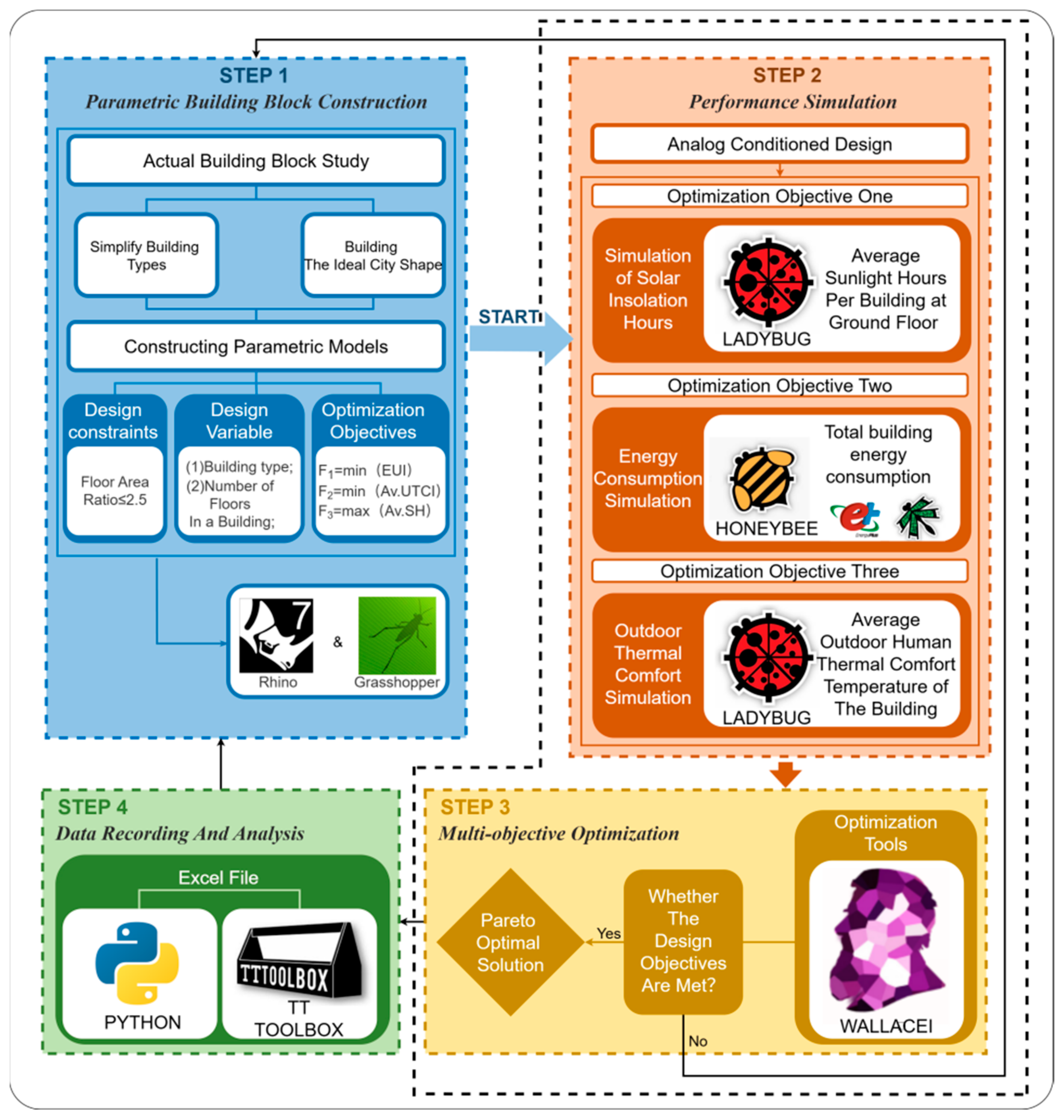
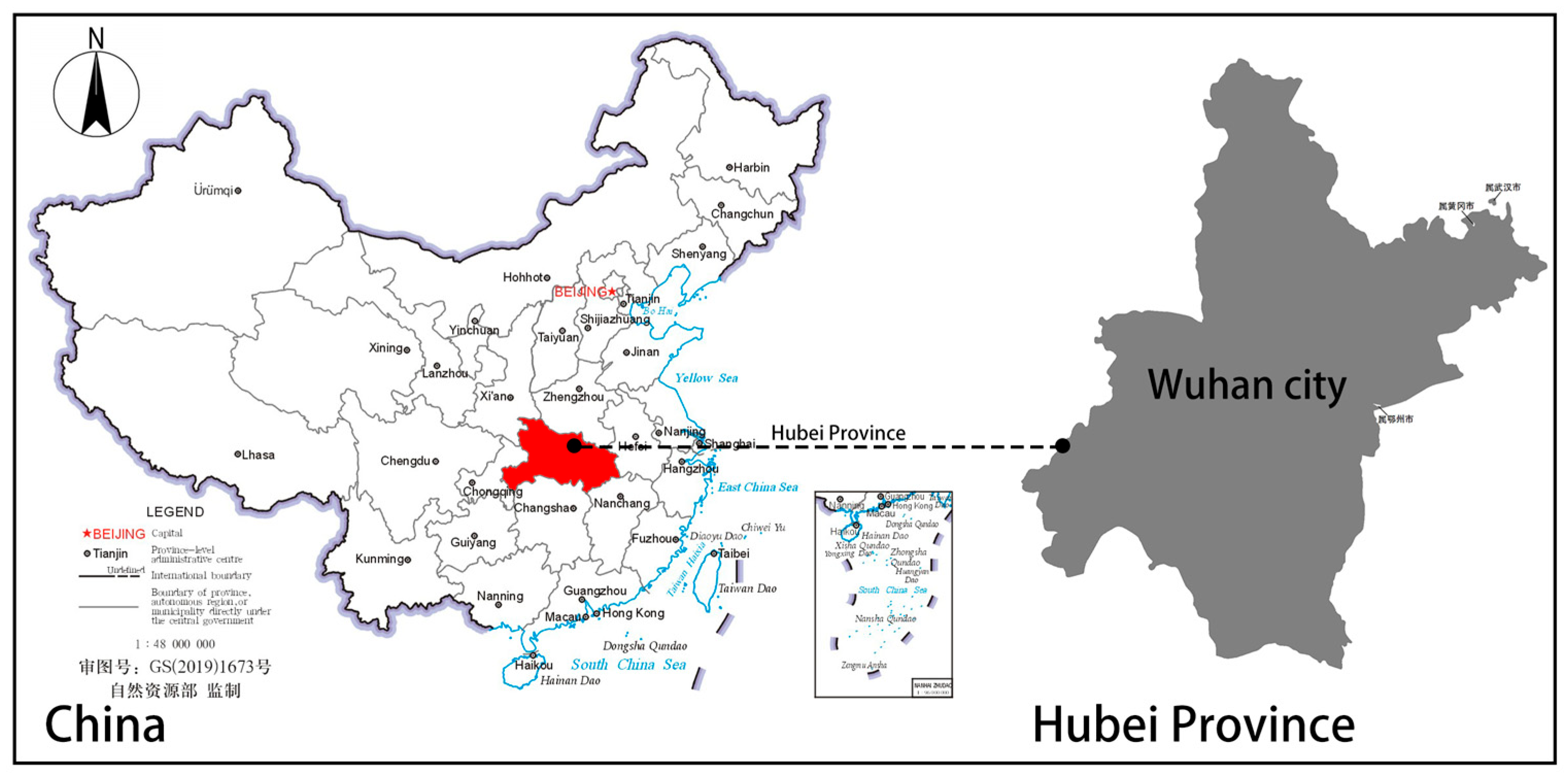
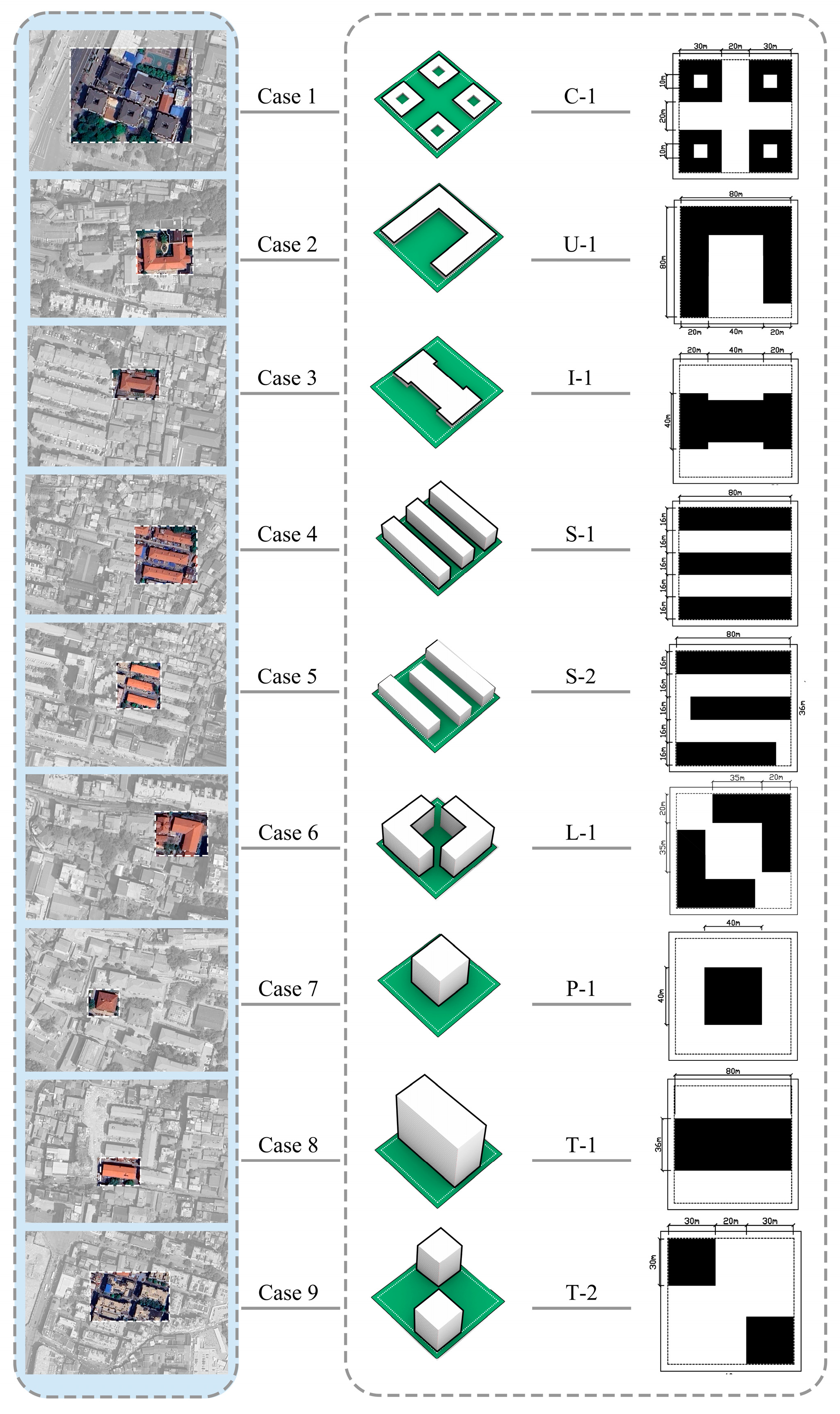



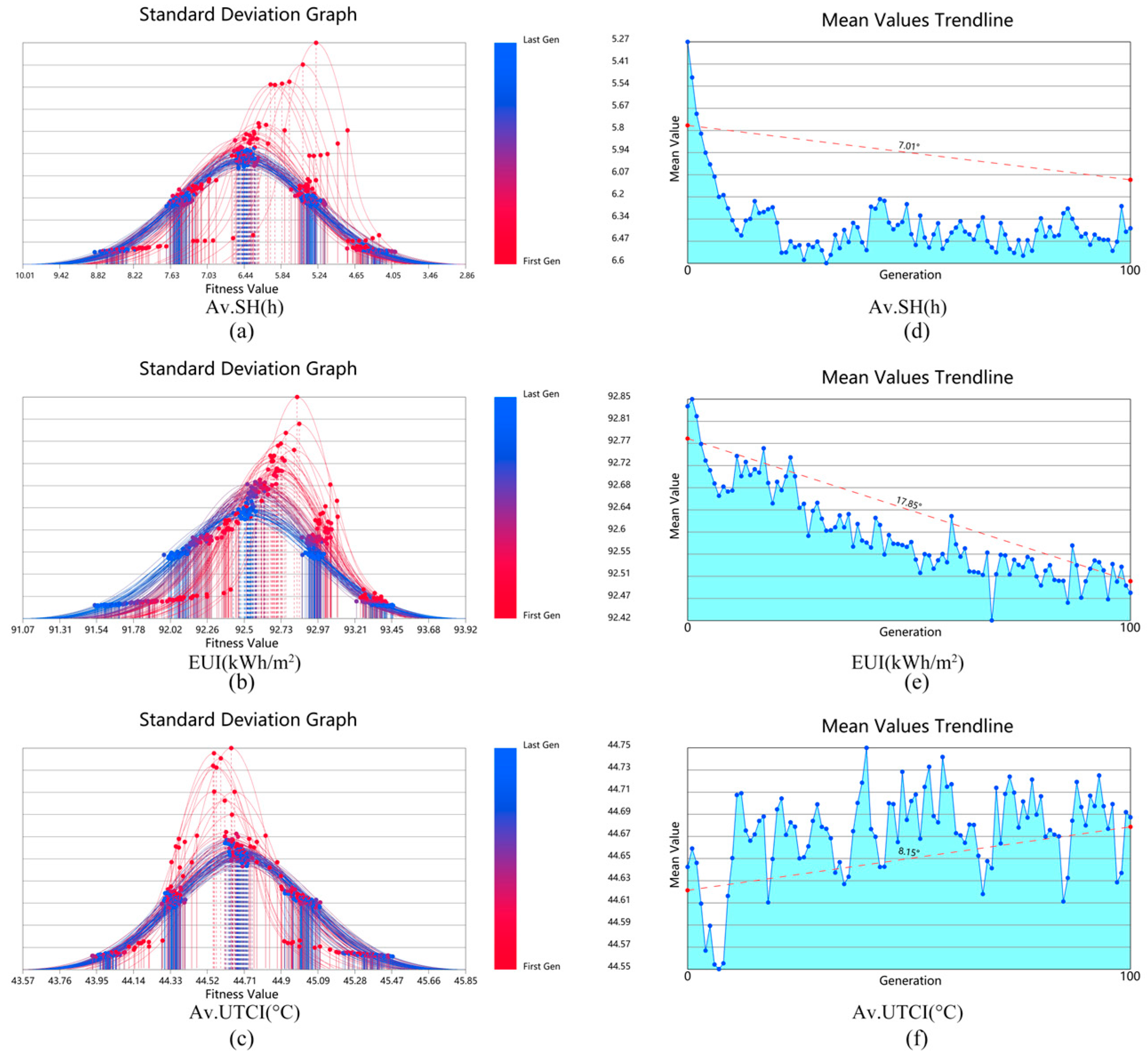
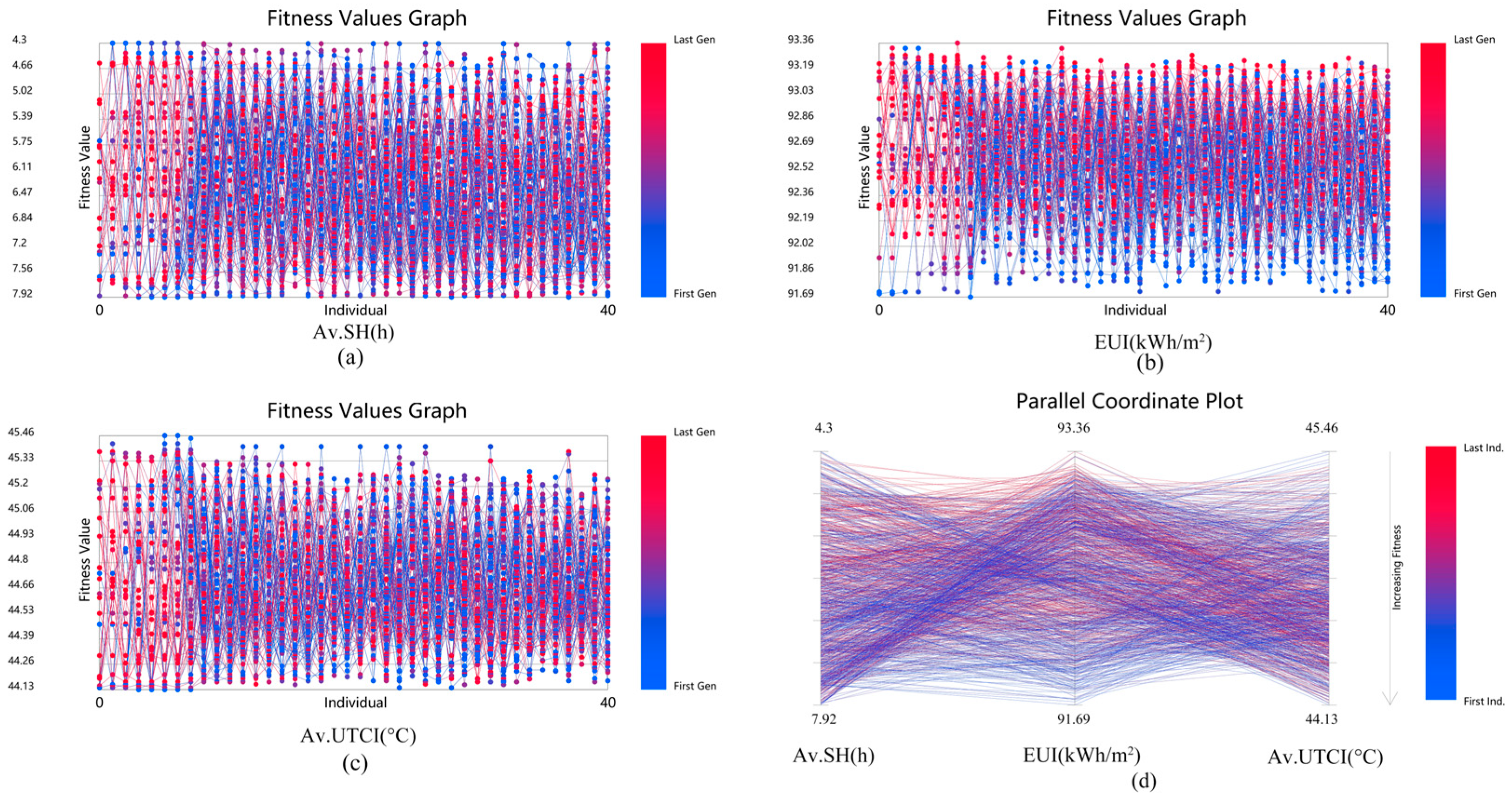




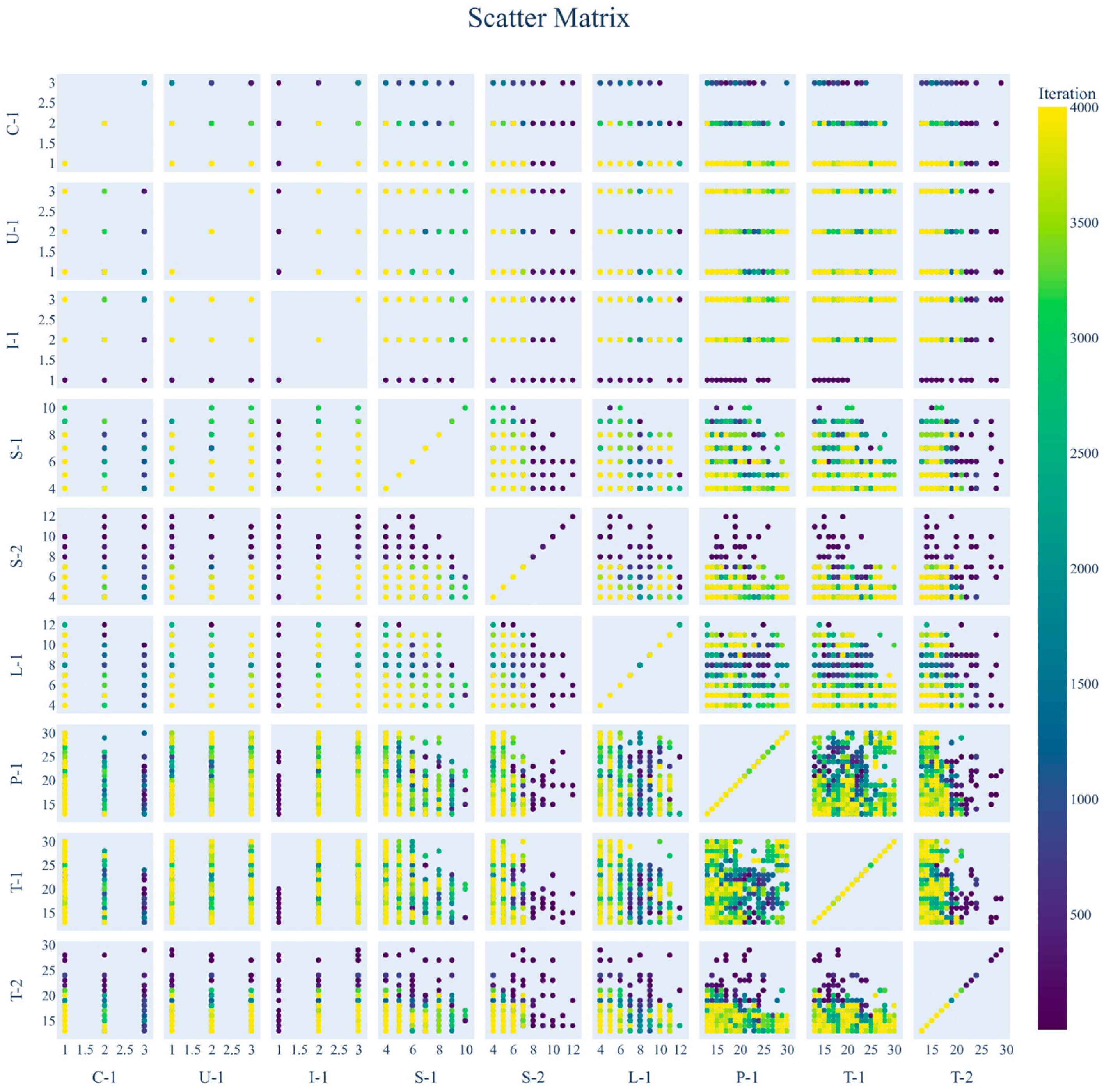

| Case | Categories | Number of Floors | Building Footprint Area (m2) | Model Number |
|---|---|---|---|---|
| Case1 | Courtyard | 1–3 | 3200 | C-1 |
| Case2 | U shape | 1–3 | 3800 | U-1 |
| Case3 | I shape | 1–3 | 2800 | I-1 |
| Case4 | Slap 1 | 4–12 | 3840 | S-1 |
| Case5 | Slap 2 | 4–12 | 3840 | S-2 |
| Case6 | L shape | 4–12 | 3600 | L-1 |
| Case7 | Point | 13–30 | 1600 | P-1 |
| Case8 | Tower 1 | 13–30 | 2800 | T-1 |
| Case9 | Tower 2 | 13–30 | 1800 | T-2 |
| Geometric Parameter | Abbreviated | Formula | Diagram Form |
|---|---|---|---|
| Average Sunlight Hours | Av.SH | 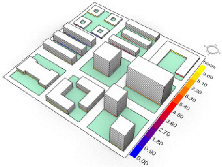 | |
| Building Energy Consumption | EUI |  | |
| Average Universal Thermal Climate Index | Av.UTCI | 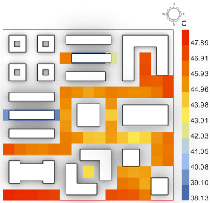 |
| Parameter | Setting | |
|---|---|---|
| Weather data | EPW files modified based on simulated microclimate results of UWG | |
| Simulation period | From 1 January to 31 December | |
| Constructions | Exterior_wall | U value = 0.59 W/m2·K |
| Exterior_roof | U value = 0.20 W/m2·K | |
| Exposed_floor | U value = 0.39 W/m2·K | |
| Ground_wall | U value = 2.89 W/m2·K | |
| Ground_roof | U value = 0.40 W/m2·K | |
| Ground_floor | U value = 2.01 W/m2·K | |
| Window | U value = 2.40 W/m2·K | |
| Window Ratio Parameters | 0.25 | |
| Watts_per_area | 25 W/m2 | |
| COP Coefficient of Performance | 4.5 |
| Generation Size | Generation Count | Crossover Probability | Mutation Probability | Random Seed |
|---|---|---|---|---|
| 40 | 50 | 0.9 | Default | 1 |
| Generation Size | Generation Count | Crossover Probability | Mutation Probability | Random Seed |
|---|---|---|---|---|
| 40 | 100 | 0.8 | 0.5 | 1 |
Disclaimer/Publisher’s Note: The statements, opinions and data contained in all publications are solely those of the individual author(s) and contributor(s) and not of MDPI and/or the editor(s). MDPI and/or the editor(s) disclaim responsibility for any injury to people or property resulting from any ideas, methods, instructions or products referred to in the content. |
© 2025 by the authors. Licensee MDPI, Basel, Switzerland. This article is an open access article distributed under the terms and conditions of the Creative Commons Attribution (CC BY) license (https://creativecommons.org/licenses/by/4.0/).
Share and Cite
Li, L.; Zhang, C.; Niu, C.; Zhang, H. Parametric Multi-Objective Optimization of Urban Block Morphology Using NSGA-II: A Case Study in Wuhan, China. Sustainability 2025, 17, 9724. https://doi.org/10.3390/su17219724
Li L, Zhang C, Niu C, Zhang H. Parametric Multi-Objective Optimization of Urban Block Morphology Using NSGA-II: A Case Study in Wuhan, China. Sustainability. 2025; 17(21):9724. https://doi.org/10.3390/su17219724
Chicago/Turabian StyleLi, Liyuan, Changzhi Zhang, Chuang Niu, and Hao Zhang. 2025. "Parametric Multi-Objective Optimization of Urban Block Morphology Using NSGA-II: A Case Study in Wuhan, China" Sustainability 17, no. 21: 9724. https://doi.org/10.3390/su17219724
APA StyleLi, L., Zhang, C., Niu, C., & Zhang, H. (2025). Parametric Multi-Objective Optimization of Urban Block Morphology Using NSGA-II: A Case Study in Wuhan, China. Sustainability, 17(21), 9724. https://doi.org/10.3390/su17219724






